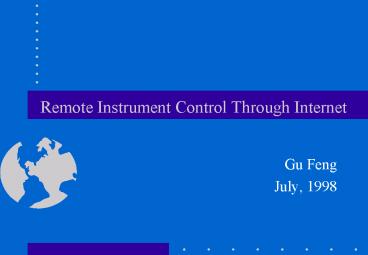Remote Instrument Control Through Internet - PowerPoint PPT Presentation
1 / 21
Title:
Remote Instrument Control Through Internet
Description:
CGI is an acronym for the Common Gateway Interface, which defines the standard ... platform independent. compile once, run anywhere. java applet can run on client side ... – PowerPoint PPT presentation
Number of Views:125
Avg rating:3.0/5.0
Title: Remote Instrument Control Through Internet
1
Remote Instrument Control Through Internet
- Gu Feng
- July, 1998
2
Content
- Introduction
- Development of RICI using CGI
- Development of RICI using Java
- Conclusion
- Future Work
3
Introduction
- Possibility of RICI
- Unified user interface
- Ease of usage
- Interactivity
- Benefit
4
Introduction
- System Structure
5
Development of RICI using CGI
- CGI is an acronym for the Common Gateway
Interface, which defines the standard way in
which external programs should communicate with a
Web server. - Typical procedure of controlling a remote
instrument - Using any internet browser to connect to the web
site where the instrument is located. - The web server will provide a web page, which
enables users to enter desired instrument
parameters and submit them to the web server.
6
Development of RICI using CGI
- The CGI program on the web server will determine
whether the entered parameters are acceptable or
not. - If the entered parameters are acceptable, the CGI
program will generate commands and transfer the
commands to the Lab PC to which the instrument is
connected and controlled. - The Lab PC will execute the commands and acquire
output of the instrument.
7
Development of RICI using CGI
- The acquired data will be transferred from the
Lab PC to the CGI program. - The CGI program will then translate the acquired
data to HTML format and send them to the remote
user.
8
Development of RICI using CGI
AD/DA Card GPIB Card, etc.
Virtual Instrument
Software
- What is Virtual Instrument?
9
Development of RICI using CGI
- Virtual Instrument - Sine wave signal generator
10
Development of RICI using CGI
- Demonstration
- Start page
- Result page
11
Development of RICI using Java
- Java
- platform independent
- compile once, run anywhere
- java applet can run on client side
- more flexibility, interactivity and immediacy
- continuous connection between client and server
- more friendly and easy-to-use user interface
12
Development of RICI using Java
- Typical procedure of controlling a remote
instrument - Using any internet browser to connect to the web
site where the instrument is located. - The web browser will automatically download a
java applet and run it. - The Java applet will establish a TCP connection
with the server program running on web server.
13
Development of RICI using Java
- The user will enter desired parameters and click
ltrungt button. - The java applet will send the parameters to the
server program. - The server program will determine whether the
entered parameters are acceptable or not. - If the entered parameters are acceptable, the
server program will generate commands and
transfer the commands to the Lab PC to which the
instrument is connected and controlled.
14
Development of RICI using Java
- The Lab PC will execute the commands and acquire
output of the instrument. - The acquired data will be transferred from the
Lab PC to the server program. - The server program will then generate a GIF file
according to the acquired data and inform the
java applet that the GIF file is ready.
15
Development of RICI using Java
- The Java applet will fetch the GIF file and
display it on the users screen. - To get a new result, the user just need to change
the value of parameters and click ltrungt button.
16
Development of RICI using Java
Demonstration - Start page
17
Development of RICI using Java
Demonstration - Result page
18
Conclusion
Difference between CGI method and Java method
19
Conclusion
Difference between CGI method and Java method
20
Conclusion
21
Future Work
- authentication
- encryption of transmission
- integration with Computer Supported Cooperative
Work - potential application in industry































